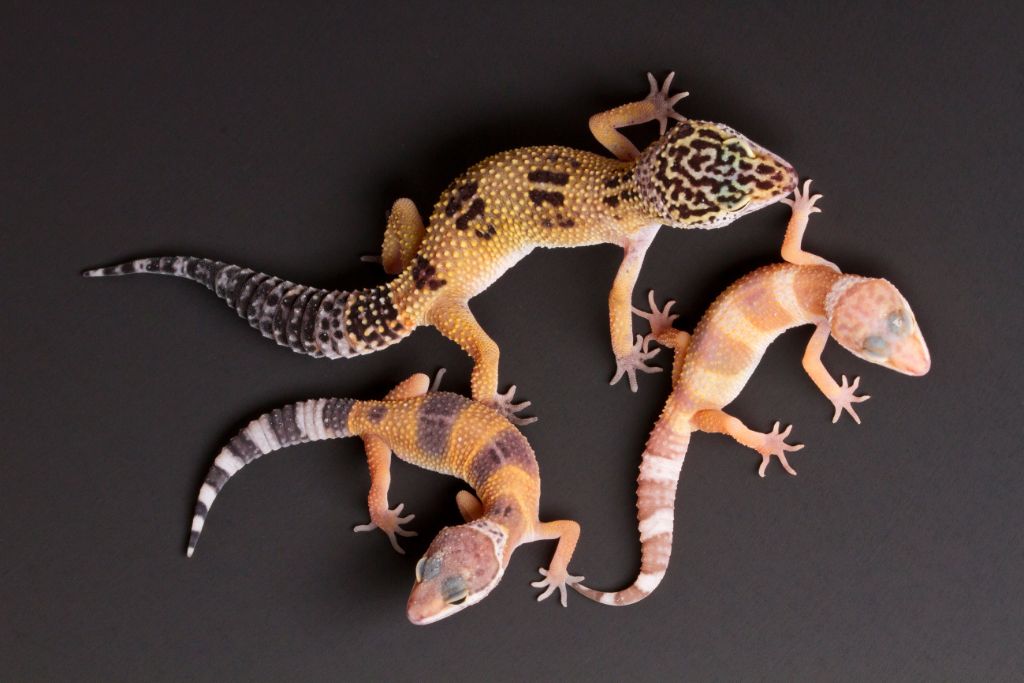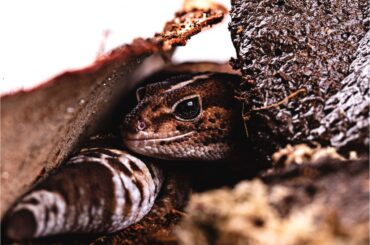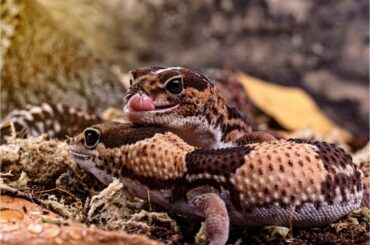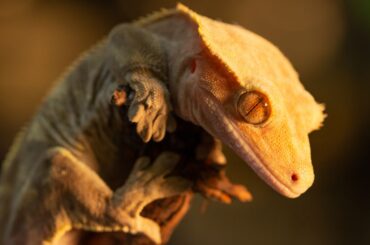Are you fascinated by the enchanting world of reptiles? Do you dream of taking care of your very own gecko family? If so, you’re in for an exciting journey into the world of leopard gecko breeding!
Reptile enthusiasts interested in leopard gecko breeding have grown in recent years. Breeding leopard geckos is fun and helps conserve these fantastic animals. Breeders protect and improve species by breeding responsibly and fostering healthy genetics.
There is a lot of responsibility that comes along with the joy of breeding leopard geckos. The health and happiness of the geckos in a breeder’s care must be their top priority. Responsible breeding includes gecko health, genetic variety, and offspring care.
Understanding Leopard Gecko Breeding
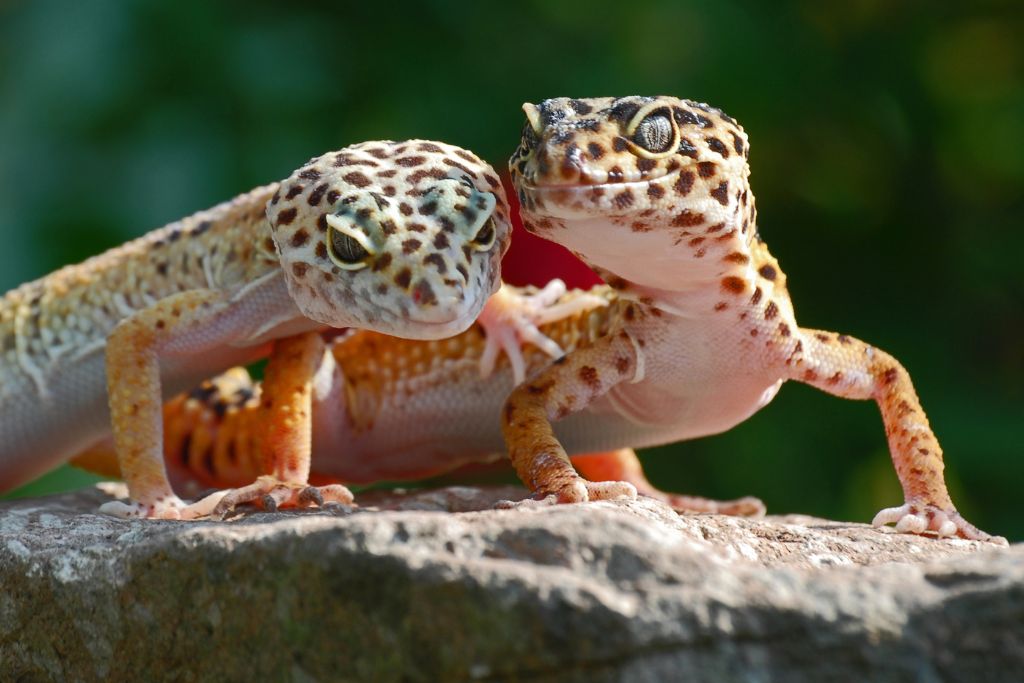
Breeding these amazing species opens up a world of discovery and lets you see nature’s wonders. From knowing their reproductive cycle to caring for them, here’s the leopard gecko breeding process:
Life Cycle
Leopard geckos, fascinating animals from Central Asia’s dry regions, have multiple life stages. Each stage plays a crucial role in their growth and development from hatching to adulthood.
The journey of a leopard gecko begins with hatching from an egg. These delicate hatchlings have all their species’ traits but need special care. As they grow, they enter the juvenile stage, marked by rapid growth and exploration of their surroundings.
Sub-adult leopard geckos develop their own set of identifying features. This stage is a significant transition period before they reach adulthood. They mature into adults with brilliant colors and unique patterns.
It is essential to note that leopard geckos should reach sexual maturity before breeding. Breeding too early can have adverse effects on their health and development. By letting them grow to their greatest potential, we prepare geckos for reproduction.
Reproductive Biology
Leopard geckos possess intriguing reproductive traits that stand out among other reptiles. One remarkable ability they have is sperm storage. Females can store sperm from one mating session to fertilize their eggs several times.
Ovulation in leopard geckos occurs with adequate males and favorable environmental conditions. Once the female is ready to lay eggs, she goes through ovulation, where the eggs develop within her body. After a four-week gestation, the female puts her eggs in a safe place to hatch after two months.
During the breeding season, leopard geckos exhibit unique reproductive behaviors and courtship rituals. Males mark their territory with scent and gently nudge to attract females.
The courtship ritual often involves the male bobbing his head and swaying his tail to impress the female. Once the female accepts the male’s advances, they engage in copulation, leading to the potential fertilization of her eggs.
We can appreciate leopard gecko breeding by understanding their life cycle and reproductive biology. These magnificent reptiles are healthy and well-cared for by letting them develop before breeding.
Preparing for Breeding
Reptiles can be a rewarding experience that allows you to witness the wonders of nature firsthand. Here are the steps needed to breed leopard geckos safely:
Selecting Breeding Stock
Breeding leopard geckos requires healthy, genetically diversified stock. This ensures the overall success and well-being of the offspring. Genetic diversity prevents inbreeding and helps healthy geckos produce strong and resilient hatchlings.
Several factors need to be considered when selecting suitable breeding pairs. As a first consideration, gecko age is essential. Females should be one years old, and males eight to ten months old before breeding. This ensures that they have reached sexual maturity and are physically capable of reproducing.
Weight is also an important aspect to consider. Females should be healthy, neither underweight nor overweight, to deposit eggs and raise their young.
Lastly, overall health is vital. Geckos must be healthy because they can pass on diseases, parasites, and abnormalities.
Creating Optimal Breeding Conditions
Specific habitat setups must be in place to create the best environment for breeding leopard geckos. Temperature plays a critical role in their reproductive success. By keeping one side of the enclosure between 88°F and 90°F (31°C-32°C) and the other between 78°F and 82°F (25°C-28°C), geckos can modify their body temperature.
Leopard geckos are arid species and don’t need high humidity. Therefore, 20% to 40% is ideal. Providing a proper lighting setup with a day and night cycle is essential. A full-spectrum UVB bulb simulates natural sunlight and delivers vitamin D3 to geckos.
Substrate selection is also significant. Avoid using loose substrates, such as sand or gravel, as they can cause impaction if ingested. A solid substrate, like reptile carpet or paper towels, is recommended to prevent potential health risks.
Apart from the habitat setup, providing appropriate hides and nesting areas for successful breeding is essential. Leopard geckos are nocturnal creatures and require hiding spots to feel secure and reduce stress.
They can hide in half-logs, tunnels, or commercial reptile hides throughout the habitat. A nesting box with damp soil and sand encourages females to deposit eggs.
How to Breed Leopard Geckos
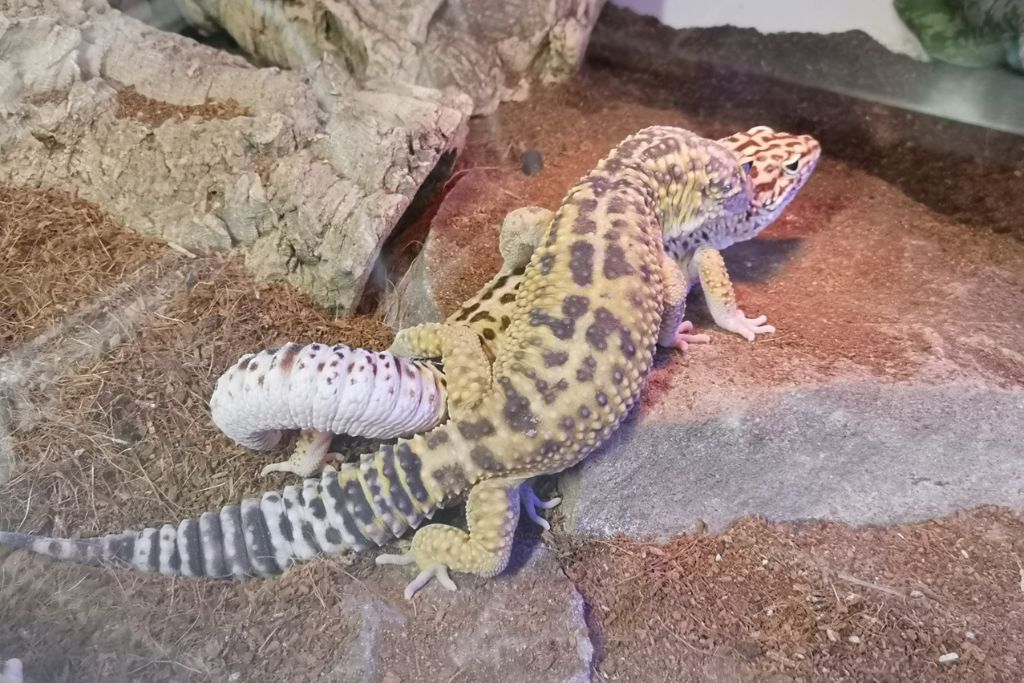
Breeding leopard geckos can be an exciting and rewarding experience. Here are the general steps to successfully breed leopard geckos:
Introduction and Courtship
Breeding leopard geckos can be a fascinating and rewarding experience. It’s essential to approach the process with care and patience. To protect geckos, breeding pairs must be introduced gradually and with a supervised approach.
It’s crucial to provide each gecko with its own space before introducing them. This helps them establish their territories and feel more comfortable. Keep the geckos in separate enclosures for a few weeks before introducing them. This allows them to become familiar with each other’s presence without direct contact.
Supervised introductions can begin once the geckos are used to their neighbors. Place them in a neutral space, like a separate enclosure, and observe their behavior closely.
Leopard geckos show interest in this period by courting. These behaviors can include tail-waving, circling, and even vocalizations. It’s crucial to ensure that these interactions remain gentle and do not escalate into aggression.
Copulation and Leopard Gecko Laying Eggs
After successful courtship, leopard geckos proceed to the copulation process. During copulation, the male gecko will approach the female from behind and grip her neck with his jaws. This position, known as the “mating grip,” allows the male to transfer sperm to the female. It’s important to note that copulation can occur multiple times over several days.
Following copulation, a mating plug may form. This plug is a mixture of sperm and a waxy substance produced by the male gecko’s reproductive organs. The plug acts as a barrier to prevent other males from mating with the female and ensures the fertilization of her eggs.
In the weeks following leopard gecko pregnancy, the female leopard gecko will prepare to lay her eggs. She needs a shallow container with moistened vermiculite or another substrate to nest.
The female will dig a burrow in the substrate, where she will deposit her eggs. To optimize egg development, check nesting area temperature and humidity.
Incubation and Hatching: Leopard Gecko Eggs
Once the female has laid her eggs, they must be carefully incubated for proper development. Place the eggs in an incubator with a temperature between 80°F (27°C) and 90°F (32°C). The eggs should be placed in an upright position to mimic their natural orientation. Maintain a consistent humidity level between 80% and 90% to prevent the eggs from drying.
The incubation period for leopard gecko eggs usually lasts 45 to 60 days. During this time, monitoring the temperature and humidity levels within the incubator is essential. You may also need to rotate the eggs gently to prevent the embryos from sticking to the shell.
As the eggs near the end of the incubation period, you may notice slight changes in their appearance. The eggs will become slightly dimpled, indicating that the embryos are developing.
There will be a gradual opening of the shell until the hatchlings emerge. Hatchlings must burst out of their shells alone to improve their muscles, so don’t help.
Once the leopard gecko hatchlings fully emerge, they will be delicate and vulnerable. Provide them with a small enclosure equipped with appropriate heating and hiding spots. Offer them a diet of appropriately sized live insects, such as small crickets or mealworms. Handle hatchlings carefully and let them acclimate before interacting.
Post-Breeding Considerations
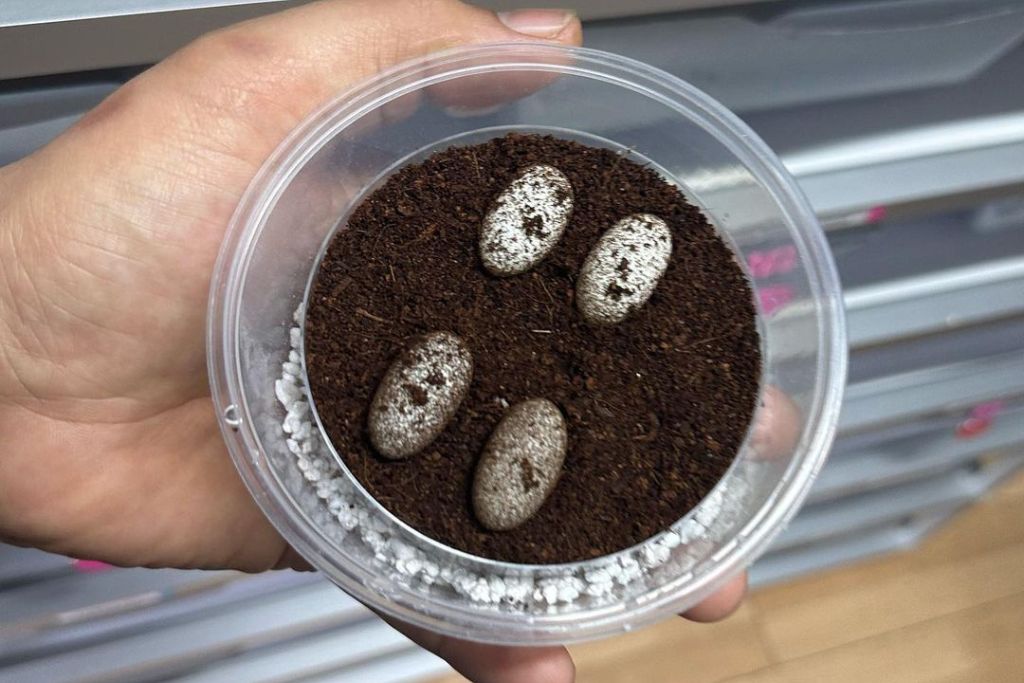
After mating geckos, focus on post-breeding care to keep them healthy. The parent geckos and their offspring’s health and happiness depend on this phase. Here are some key factors to keep in mind during the post-breeding stage:
Post-Breeding Care
After the breeding season, leopard geckos need special care. One crucial aspect is their nutritional requirements. A balanced diet plays a vital role in maintaining the health of breeding leopard geckos.
These remarkable reptiles require diverse nutrients, including vitamins, minerals, and proteins. They can meet their nutritional demands by eating crickets, mealworms, and waxworms. Dusting their food with a calcium supplement prevents calcium deficits and metabolic bone disease.
Apart from their diet, providing adequate space and monitoring the health of the breeding pair is essential. Leopard geckos need ample space in their enclosure to behave naturally. A spacious vivarium with appropriate temperature gradients and hiding spots will help create a stress-free environment.
Keeping an eye out for strange behavior, weight loss, or appetite changes in geckos is essential. Consult a reptile vet immediately if you have any concerns.
Genetic Considerations
Understanding genetic inheritance is key when breeding leopard geckos. Each gecko’s genes can affect its appearance. When breeding specific morphs, it’s essential to consider the potential outcomes of the offspring.
Mixing morphs can create beautiful colorations and patterns, but beware of genetic concerns. Some morphs carry recessive traits that, when combined, can result in health problems or deformities. Responsible breeders should study morph genetics to make breeding decisions.
Responsible breeding practices are crucial to maintain genetic diversity and prevent genetic issues. Avoid excessive inbreeding, which can reduce the gene pool and increase health risks. Breeding geckos from diverse bloodlines reduces genetic problems.
Breeders can help leopard gecko populations survive by prioritizing gecko health above morph production. It’s important to be mindful of the impact breeding decisions can have on the overall genetic health of the species.
Conclusion
Breeding leopard geckos is a fascinating and rewarding journey. Understanding and caring for these remarkable species can help conserve them. Watching leopard gecko hatchlings grow and develop is magical and teaches us responsibility and empathy.
Breeding geckos lets us share our love and help preserve this magnificent species. Let’s continue to explore the world of leopard geckos and positively impact their conservation efforts. We can make a difference and protect these beautiful creatures for years.
FAQs
Are Leopard Geckos Easy to Breed?
Leopard Geckos are easy to breed, making them popular among reptile enthusiasts. They reach sexual maturity at around 8 to 12 months of age. Once they reach this age, they can breed.
How Fast Do Leopard Geckos Breed?
Leopard geckos reproduce quickly and lay many clutches of eggs. Geckos can lay eggs every two to four weeks during the breeding season in warmer months.
How Many Eggs Do Leopard Geckos Lay at Once?
A female leopard gecko can lay one to two eggs, sometimes three or four. The number of eggs laid can vary depending on the female’s health, age, and breeding conditions.
What is the Best Age to Breed Leopard Geckos?
Leopard geckos are best bred between 8 to 12 months when they achieve sexual maturity. Before breeding, ensure the male and female geckos are healthy and sized. Successful reproduction requires a suitable temperature and humidity environment.

